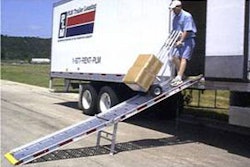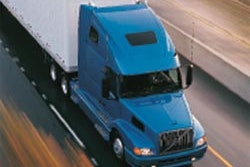Electronic On Board Recorders (EOBR’s) are now available from several sources, easing the burden of hours-of service compliance for drivers and carriers, and providing many ancillary benefits, as well.
Making the right choices on whether or not to invest in EOBR’s, choosing the right product, and implementing a program in your fleet will be critical to your success. Making the wrong choices could result in your failure to comply with the regulations, and possibly even losing your fleet’s operating authority as well as potential corporate, and even personal, liability for violators.
It is, therefore, important to understand what EOBR’s do, how they work, and what they can do for your fleet.
Just as in the airline, maritime, oil production and railroad industries, commercial motor vehicle operators and drivers in the United States and Canada must comply with hours of service regulations, the purpose of which is to prevent tired drivers from driving and endangering themselves and others. These drivers, and their employers, face the task of maintaining compliance with the regulations, while at the same time maximizing productivity and profitability.
Failure to comply with hours of service regulations often results in unsafe driving practices, increased risk to all members of the driving public and increased exposure to litigation for the carrier and its officers. Penalties for non-compliance can range from moderate fines to very expensive fines, loss of operating authority, and incarceration for egregious violators.
By regulation, drivers have a limited number of hours they may drive and a limited number of hours they may work (including on-duty not driving). Once these limits are reached, a period of off-duty time or sleeper berth time must be taken to “reset” tour of duty limits.
If a sleeper berth is used, drivers may accumulate the total number of hours needed to rest in more than one period of time, provided certain rules are met. In addition, drivers can accumulate only a certain number of hours in any previous seven-, eight- or (in Canada only) 14-day period.
The United States and Canada each have their own hours of service regulations, with different required work, driving, resting and total accumulated working times. Mexico does not currently have HOS regulations, but NAFTA and other influences could initiate legislation there.
Many states have rules that differ from the federal rule, applicable when a vehicle does not travel outside the borders of that state. All Canadian provinces have varying rules for commercial motor vehicles operating within their borders.
Both Canada and the United States have specific hours of service rule sets that apply only to specific vocations. These vocations include agriculture, water well drilling, oil well drilling, utilities, home fuel deliveries and essential transportation modes during times of great need.
Drivers must use a “record of duty status,” commonly referred to as a log book, to monitor and prove compliance with the hours of service regulations applicable. Drivers and carriers must keep these logs for a specified period of time—usually six months—in the event of an audit.
The Background of Automated Hours of Service Compliance
Current laws in both the United States and Canada allow electronic logs in the place of handwritten records. The exact stipulations for these electronic devices are specific, and are expected to become more stringent with upcoming regulatory and legislative actions. Some industry watchers are expecting a mandate of these devices because of highway safety and security concerns.
Thousands of fleets have used electronic logs since 1988, easing the burden of compliance and reaping productivity benefits. There is currently no mandate for electronic logs, so fleets must find some benefit to justify the costs. Fleets may simply want to be good corporate citizens, ensuring that their vehicles are operated in a safe manner. Some fleets operate in a hazardous environment where safety and fatigue management are paramount. Many fleets obtain a return on their investment through other benefits of an onboard computer, such as better driving habits and productivity.
Several times since 1988, calls have been made by various groups to mandate electronic log devices in the name of highway safety. The Federal Motor Carrier Administration (FMCSA) calls these devices Electronic Onboard Recorders (EOBR’s). An EOBR is a device that electronically automates drivers HOS record-keeping requirements.
An EOBR, by definition, does not include any other functionality such as fuel taxes, driving performance or productivity tools. However, because fleets demand these other functions to obtain their return on investment, there are no pure EOBR devices on the market today.
While compliant electronic log devices have existed for 20 years, not all electronic log devices are compliant with the FMCSA rules. Non-compliant devices cannot be used in lieu of handwritten logs. By regulation, it is the carrier that bears the responsibility of compliance, not the manufacturer of the device.
What makes an EOBR Compliant?
In the United States, CFR 49 Part 395.15 details the specific regulations concerning an EOBR. However, Part 395 must be considered in its entirety when determining if a device is compliant. Compliance is measured in conformance to the specific EOBR regulations, ease of use by the driver, accuracy, tamper resistance and acceptance as an accurate log by inspectors.
It is important to remember that the use of an EOBR does not exempt drivers or carriers from compliance with the FMCSA’s regulations. Carriers must still protect the audit trail, drivers must still comply with HOS requirements, and logs can not be tampered with or unlawfully altered.
The spirit of 395.15 is to ensure the integrity of EOBR-generated drivers’ daily logs.
Is the EOBR powered by the vehicle, is it portable or integrated into the vehicle and does it reliably keep date and time? In order to be reliable and tamper-resistant, an EOBR must be integrated into the vehicle so that it can not be easily defeated, altered or turned off. This is of primary consideration when determining the reliability of an EOBR. You simply cannot use a device that can be disabled and still be compliant. Auditors and inspectors use recorded distance to audit the accuracy of drivers’ logs. Therefore, accurate distance is important, although an EOBR is not required to record or display speed.
Does the device obtain distance from the vehicle? Obtaining distance from a vehicle sensor or data bus is considered accurate if the device is properly calibrated. Obtaining distance from an external source such as GPS, is not adequate,due to the nature of GPS signal loss and the resulting missing distance.
A study by the University of Oregon concluded that up to 28 percent of actual distance can be lost with a GPS-only device. It has been concluded that certain types of topographical features create a higher loss of GPS signal, with urban and mountainous, forested areas leading the list.
Is the driver’s entire history available onboard? All required history must be stored in and retrievable from the automatic onboard recording device, and must be accessible immediately upon demand. Wireless communications systems alone cannot be relied on to retrieve a history of status changes while on the road. Drivers are required to keep eight days history, including the current day, on board.
Can the EOBR handle multiple drivers? The device must be capable of handling every commercial driver in the vehicle, calculate and display their hours and their status changes separately.
How is slip-seating handled? This is an example of how the entire context of Part 395 must be used to determine a device’s compliance. While slip-seating is not specifically mentioned, it is clear that an EOBR must store and calculate onboard the drivers’ hours and status changes. All drivers’ histories must be immediately available.
How are edits handled? Drivers will make mistakes in logging on and off duty. However, drivers are expressly prohibited from correcting or editing entries they make in the vehicle. Asked to clarify the regulation, the FMCSA declined to allow driver edits, responding:
“If drivers who use automatic onboard recording devices were allowed to amend their record of duty status while in transit, legitimate amendments could not be distinguished from falsifications. Records of duty status maintained and generated by an automatic onboard recording device may only be amended by a supervisory motor carrier official to accurately reflect the driver’s activity. Such supervisory motor carrier official must include an explanation of the mistake in the remarks section of either the original or amended record of duty status. Both the original and the amended record of duty status must be retained by the motor carrier.”
Carriers need to make sure that the system is easily operated by drivers, reducing the opportunity for driver errors. When corrections are needed, the system must handle these edits so that the FMCSA does not view these edits as log falsifications.
Can the EOBR accurately handle all of the applicable hours of service regulations for the geography you operate in, and in your specific vocation? Alaska, California, Florida and Texas have rules that differ from the federal rules for all intrastate commerce. These rules generally look like the U.S. federal rules prior to 2003, except more driving time is allowed than under the federal regulations.
All Canadian provinces have rules that differ from each other and from the Canadian federal hours of service guidelines. Some vocations, most notably oil and water drilling operations, have exemptions from federal and state regulations in the number of hours required for a reset, driving allowed and on-duty allowed.
Both Canada and the United States allow vocational exemptions. There are currently 26 hours of service rule sets in North America covering these exceptions and exemptions. These rules sets will likely become more numerous as more stringent regulations bring about more requests for exemptions and exceptions.
Is the EOBR vendor a viable business partner? To answer this, you need to ask: Does the supplier have the financial viability to provide innovative products and to support its products over an extended period of time? Does the vendor possess the technical expertise to assist you in training, implementation and audits? What do others say about the quality of its products and services? Does it have the experience to offer meaningful advice and to integrate its experience into its product design?
What benefits are derived from paperless hours of service logging?
Drivers appreciate electronic logs. The implementation of an EOBR system creates a positive impression that the company cares about safety and is committed to giving drivers a reasonable and legal work environment.
Properly preparing hand-written logs is time-consuming, involves several math computations and displaces part of the driver’s focus on his real job. It is common for drivers to save 15-30 minutes per day when they do not have to fill out paper logs. Supervisors can easily track drivers’ availability. This enhances planning and dispatching, allowing the most capable driver to handle appropriate tasks.
With the proper exception reporting tools, supervisors will not need to review each individual log, focusing on exceptions and violations. It is a carrier’s responsibility to review each log submitted by every driver. The ability to focus solely on the problems can create tremendous time savings.
Risk management can ensure that company and regulatory standards are adhered to, reducing the risk of fatigue-related incidents and providing an extra layer of protection from litigious activities. Company standards can be more creative and tailored for a specific operation because of the ability to accurately track drivers’ activities.
Some EOBRs grade and monitor driving performance. This allows management to become proactive so that the little incidents do not turn into the big incident. Some EOBR’s provide detailed accident and incident recording, providing valuable insight during investigation. This insight can guide management on the proper handling of corrective action and litigation.
Because many EOBR’s and onboard computers measure and monitor many vehicle and driver activities, fleets use this information to impact the bottom line. Fleets realize a return on their investment in areas such as:
• Fuel savings through reduced speed, idle, and panic stops;
• Automation of clerical functions, such as payroll and customer deliveries;
• Improved fleet utilization with better driver work discipline and route planning;
• Automation of other regulatory information such as IRP and IFTA;
• Better fleet and corporate image; and
• Better customer service by tracking vehicles and deliveries.
What can I expect from a fully compliant EOBR system?
• An onboard computer or EOBR system should provide the assurance that it will adequately and accurately record and report on drivers’ hours of service activities.• Log books will become obsolete, focusing drivers on their job.
• Supervisors will be able to manage individual exceptions and events, freeing up time for more meaningful activities.
• Risk can be better managed by creating more intelligent safety initiatives and insuring compliance.
• Because electronic logs have been allowed since 1988, there should be little risk implementing EOBR’s.
Be certain that your vendor has the experience and resources to guide you through the implementation period. Decide what areas of your organization will benefit from EOBR’s, and aggressively track your return on investment.

















